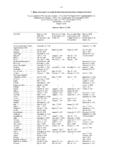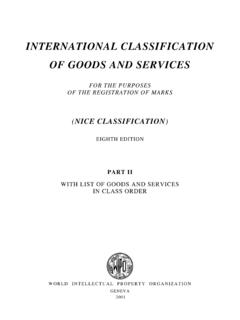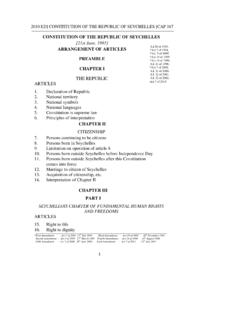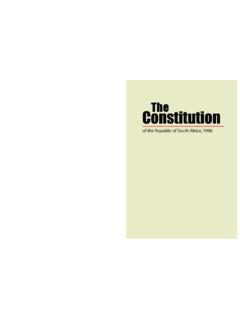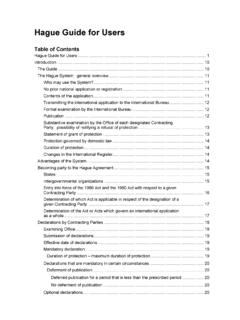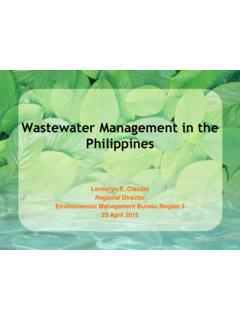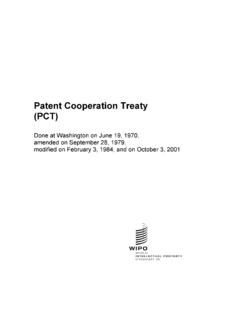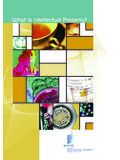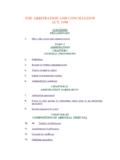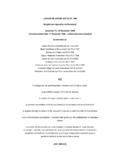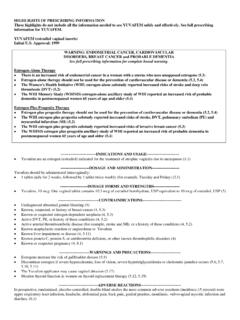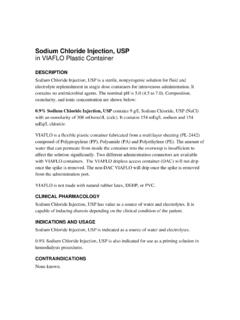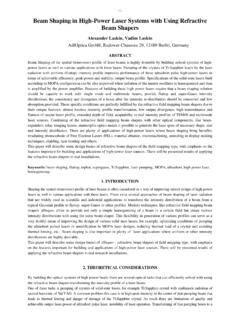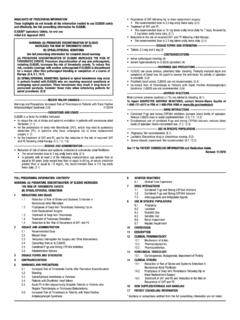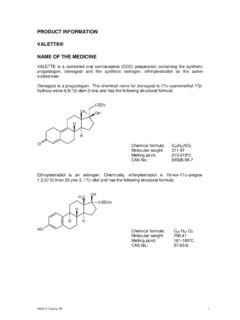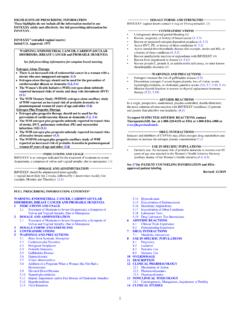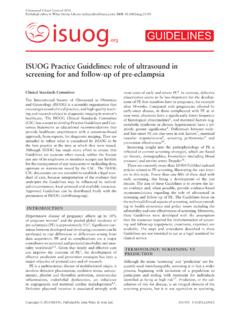Transcription of PARALLEL IMPORTS IN PHARMACEUTICALS: …
1 1 PARALLEL IMPORTS IN PHARMACEUTICALS: IMPLICATIONS FORCOMPETITION AND PRICES IN DEVELOPING COUNTRIESK eith E. MaskusProfessor of EconomicsUniversity of Colorado at BoulderUCB 256, Boulder CO 80309-0256 Report to World Intellectual Property OrganizationUnder terms of Special Service AgreementDraft: April 200121. IntroductionParallel IMPORTS (PI), also called gray-market IMPORTS , are goods producedgenuinely under protection of a trademark, patent, or copyright, placed into circulation inone market, and then imported into a second market without the authorization of the localowner of the intellectual property right. This owner is typically a licensed local example, it is permissible for a trading firm to purchase quantities of prescriptiondrugs in Spain and import them into Sweden or Germany without the approval of thelocal distributor owning licensed patent rights.
2 Indeed, rules of the internal market in theEuropean Union permit PARALLEL trade among those countries in virtually all goods. Notethat these goods are authorized for original sale, not counterfeited or pirated , PARALLEL IMPORTS are identical to legitimate products except that they may bepackaged differently and may not carry the original manufacturer s ability of a right-holder to exclude PI legally from a particular marketdepends on the importing nation s treatment of exhaustion of intellectual property rights(IPR). As discussed further below, a regime of national exhaustion awards the right toprevent PARALLEL IMPORTS , while one of international exhaustion makes such IMPORTS of PI in the pharmaceuticals area has become a critical issue in theglobal trading system. Advocates of strong international patent rights for new medicinessupport a global policy of banning PI, arguing that if such trade were widely allowed itwould reduce profits in the research-intensive pharmaceutical sector and ultimately slowdown innovation of new drugs.
3 Moreover, PI could make it difficult for healthauthorities in different countries to sustain differential price controls and regulatoryregimes. However, public-health authorities in many countries argue that it is importantto be able to purchase drugs from the cheapest sources possible, requiring an open regimeof PI. Whether or not such IMPORTS actually occur, the threat that they might come incould force distributors to charge lower prices. It is evident that policymakers indeveloping countries especially would place a higher weight on affordability ofmedicines than on promoting R&D controversy is currently well illustrated by the lawsuit filed by 39 SouthAfrican licensed pharmaceutical distributors to overturn South Africa's 1997 MedicinesLaw. This legislation would permit South Africa's health minister to resort to PI in caseswhere a drug protected by a patent is priced at excessive levels in South Africa.
4 Further, pharmaceutical firms in industrialized nations that recently agreed to provide many oftheir HIV/AIDS drugs at low cost in Sub-Saharan African nations remain concerned thatthese drugs might come into higher-priced markets through PARALLEL exports to Korea,Japan, Brazil, and other this report I discuss these issues and present available theory and evidence onthe extent and effects of PI in drugs. In the next section I consider the legal treatment ofPI in pharmaceuticals, including provisions within international trade agreements. InSection Three I discuss available evidence on the extent to which stronger patent regimesmay be expected to raise prices of new patentable drugs in poor nations. In Section Four3I present and assess several theoretical claims about determinants of PI and their potentialimpacts on pricing and innovation.
5 In Section Five I analyze available empiricalevidence on differential prices of trademarked medicines across countries at varyinglevels of economic development. I also discuss recent work on the impacts of PI inmedicines within the EU, which has an open internal regime. In Section 6 I put forwardsome conclusions about the benefits and costs of PI in developing countries and make aseries of policy recommendations. In that regard, my essential conclusion is that there isan important rationale for restricting PARALLEL exports of medicines from low-incomecountries to high-income countries, though the former group could remain open to idea could be supplemented by regimes of regional exhaustion among poor countriesin order to increase market size within which prices are The Legal Status of PARALLEL Trade in Pharmaceuticals1 Patents provide inventors of new products and technologies the legal right toexclude rivals from making, selling, and distributing those inventions.
6 Trademarksprovide their owners the right to prevent rivals from using identical or confusinglysimilar identifying marks and trade names on their goods. A country s law concerningthe territorial exhaustion of these rights is an important component of how it regulatesand limits their use. Under national exhaustion, exclusive rights end upon first salewithin a country but IPR owners may exclude PARALLEL IMPORTS from other international exhaustion, rights are exhausted upon first sale anywhere and parallelimports cannot be excluded. A third possibility is regional exhaustion, under whichrights end upon original sale within a group of countries, thereby allowing PARALLEL tradeamong them, but are not ended by first sale outside the policy of national exhaustion amounts to a government-enforced territorialrestriction on international distribution.
7 Countries following this regime choose to isolatetheir markets from unauthorized foreign competition in legitimate goods traded underrecognized IPR protection. Thus, original manufacturers retain complete authority todistribute goods and services themselves or through dealers, including the right toexclude PI through border controls. In contrast, countries permitting PI are notterritorially segmented and do not recognize any right to exclude IMPORTS of goods incirculation also that in principle a country could treat PARALLEL IMPORTS and parallelexports (PE) separately. It is possible that a country might permit PI and ban PE in orderto encourage low prices on its market. It is also possible that a country could ban PI andpermit PE in order to sustain export opportunities for its distributors. Despite thispotential segmentation in legal regimes, I am unaware of any governments that makesuch distinctions and it is surely rare in any IPR are recognized on a territorial basis, each nation has established itsown policy covering PARALLEL IMPORTS .
8 American negotiators in the Uruguay Round tried 1 This section draws from Maskus (2000a).4to incorporate a global standard of national exhaustion into the Agreement on Trade-Related Aspects of Intellectual Property Rights (TRIPS). However, it was impossible toreach such an agreement because of divergent views on the net benefits of PI. Rather,Article Six of TRIPS simply states that:For the purposes of dispute settlement under this Agreement, subject to theprovisions of Articles 3 and 4, nothing in this Agreement shall be used toaddress the issue of the exhaustion of intellectual property believe that this language implies that no violation or limitation of a TRIPS obligationbeyond national treatment (Article Three) and most favored nation (Article Four) may beinvoked to challenge the treatment of PARALLEL IMPORTS .
9 However, there is legal debateabout this Overall, it seems that Article Six preserves the territorialprerogative to regulate PARALLEL trade. This flexibility was important in gaining theacceptance of TRIPS by many developing Undoubtedly many negotiatorsfrom developing countries considered PI to be an effective antidote to concerns about thepotential price impacts of pharmaceutical patents required by the continues over the question of whether TRIPS should be extended tomandate a uniform global policy. Some analysts advocate a global ban against PI as anatural extension of the rights of intellectual property owners to control internationaldistribution (Barfield and Groombridge, 1998). This position is advanced forcefully byrepresentatives of the research-intensive pharmaceutical firms (Bale, 1998). Otherssupport a comprehensive rule of international exhaustion and would place no restrictionson PARALLEL IMPORTS in order to integrate markets (Abbott, 1998).
10 The argument is thatrestraints against PI constitute non-tariff barriers to trade and are inconsistent with thefundamental principles of the WTO. However, advocates of this view often modify it byrecognizing the possible need for restraints in pharmaceuticals, which are subject to sharpinternational price differentials for regulatory further points should be clarified. First, opponents of PI often claim thatpermitting them would support consumer deception and trade in counterfeit goods andpirated goods. However, such arguments are irrelevant in the strict sense of assessing theimpacts of PI. Consumer deception would occur if lower-quality PARALLEL IMPORTS weremarketed as legitimate versions of higher-quality products. Counterfeiting and piracy aretrade in unauthorized versions of products, which is a different concept than parallelimports.
